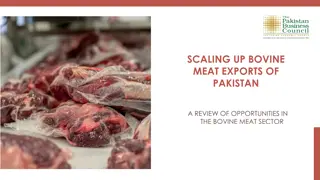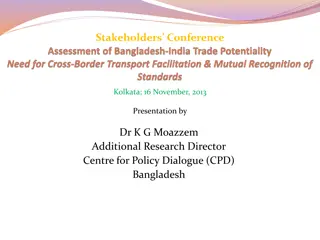Traditional Food Practices and Beliefs in India, Pakistan, and Bangladesh
Explore the historical background and traditional beliefs surrounding Indian, Pakistani, and Bangladeshi foods. Discover the differences in religious practices, the influence of Vedic scriptures on food choices, and the categorization of foods into Sattvic, Rajasic, and Tamasic categories based on their effects on the mind and body. Learn about the prevalence of Indian communities in the U.S. and the importance of yoga in promoting physical and mental well-being.
Download Presentation

Please find below an Image/Link to download the presentation.
The content on the website is provided AS IS for your information and personal use only. It may not be sold, licensed, or shared on other websites without obtaining consent from the author. Download presentation by click this link. If you encounter any issues during the download, it is possible that the publisher has removed the file from their server.
E N D
Presentation Transcript
INDIAN AND PAKISTANI FOODS
HISTORICAL BACKGROUND Food practices of India, Pakistan, & Bangladesh similar Differences in religious beliefs & practices More than 6 different religions practiced in India Many variances in foods throughout the very large geographic area of India More than 850 languages & dialects spoken, including Hindi (official language) & English
INDIANS IN THE U.S. Among the fastest growing ethnic groups in the U.S. Largest population groups in the Northeast (35%); South (24%) and West (23%) of this population group Population group relatively affluent Many professionals, small business owners, managers Very prevalent in U.S. hospitality industry
Traditional Beliefs Holy Vedic Scriptures (basis of Hinduism believed to be ageless) Categorize commonly used foods Emphasize connection between foods, moods, fitness and longevity of life Three major categories of foods, depending on kind of mind-altering, mood-provoking, and physiological influences they are believed to exert
Traditional Beliefs Food Categories: Sattvic Foods (milk, dairy products, rice, wheat, ghee, most legumes, some vegetables) Believed to make person serene, enlightened, healthy, and long- lived Calling someone sattvic is a high tribute Rajasic Foods (some meats, eggs, very bitter, sour, salty, rich, and spicy foods) Believed to make person aggressive, acquisitive, passionate, and have a desire for power
Traditional Beliefs Tamasic Foods (garlic and pickled, preserved, stale or rotten foods, alcohol & drugs used in excess for pleasure) Believed to contribute to lust, malice, confusion, slothfulness, and dullness in a person Yoga (meaning to rein in or tune the body) held in high esteem Consists of structured exercises and body positions; mental exercises and meditation to relieve from daily stresses; controlled leisure activities
Traditional Beliefs Ayurveda (Code of life and longevity): Classical system of Indian medicine practiced yet today Body and foods can interact to preserve a homeostatic harmony or cause imbalance Ayurvedic remedies prescribed for various ailments ( i.e. colds, coughs, constipation, stomach pains)
Traditional Beliefs According to Ayurveda beliefs Kapha Foods (white sugar, millet, buttermilk) are thought to be: Heavy, dense, mucus-producing Avoided by persons with respiratory ailments Vata Foods (gas-producing like legumes) Thought to be unpredictable Avoided during states of distension
Traditional Beliefs Ushna ( Hot ) Foods (black mung beans, cowpeas, ripe eggplant, papaya) Believed to promote digestion Seeta ( Cool ) Foods (cereals such as rice, wheat, mung beans, kidney beans, most fruits and vegetables, milk from most animals except goats, butter, and ghee) Impart strength and nourishment
Traditional Beliefs Moderation is advocated, even when eating the proper foods Obesity is NOT favored Solid food should fill the stomach Liquids should fill Remaining left empty for smooth digestion
Vegetarianism Vegetarianism, derived from religious beliefs, is commonly practiced Based on tenet of ahimsa , or a reverence for all life Jains, Hindus, and Buddhists all subscribe to ahimsa belief BUT Jainism only major religion in the world that is unconditionally vegetarian Lactovegetarian diet widely practiced Lacto-ovo vegetarian and vegan diets followed by some, but a lesser number of persons Non-vegetarians eat vegetarian meals on auspicious or religious occasions True for most areas; meat &/or fish allowed on these occasions in some areas
Vegetarianism Beef Consumption Forbidden Cow considered a cosmic symbol a universal mother Is a sustained supply of dairy products in a largely vegetarian diet Flesh foods ( other than beef) often an accompaniment to a starch, i.e. rice or bread
Other Religions Sikh faith does not prohibit eating meat, but: Sikh diet in villages primarily vegetarian Includes occasional meat Includes wide assortment of lentils & other legumes Langar (or community meal)- Sikhs uphold equality of all people Eat a vegetarian meal so that they offend no one Parsi s (Zorastrian) faith- follows mainly non-vegetarian diet Dishes include eggs, fish, shrimp, chicken, or goat Believe in charity Symbols of fertility (like eggs) placed on tray with raw rice, coconut, fresh flowers, and oil lamps
Other Religions Christians & Jews follow Regional food practices Use spices and condiments while retaining own beliefs and traditions Muslims in India and Pakistan Follow the Islamic food laws Some local and regional variations Practices parallel those of the Muslims in the Middle East
Food Traditions Fasting common in both India and Pakistan Also common among U.S immigrants Spices and condiments synonymous with Indian and Pakistani cuisine Kinds used vary with the dish, geographical region, and purpose Uses of spices and condiments Preserve food from spoilage in hot climates Salt Chilies Increase flavor highly aromatic cuisine Garlic Cumin Asafetida Asafetida a resin with a sharp smell, used in small quantities
Food Traditions Spices used for medicinal value- Diluted buttermilk with a pinch of salt and asafetida taken for indigestion Fresh ginger reduces distension Fenugreek (methi)- believed to help control diabetes Dried neem tree flowers, taken with rice and scalding ghee help with diarrhea Turmeric- used as an antiseptic Fenugreek seeds- used to promote lactation
Food Preparation General method of seasoning food: Oil heated in a skillet Appropriate condiments and spices are added and cooked to intensify flavors Mixture then added to cooked entr e or side dish Commonly used spices and flavorings: Caraway seeds, cayenne, cloves, chilies, bay leaves, cardamom, cinnamon, coriander, mace, mustard seeds, nutmeg, onion seeds, black pepper, saffron, sesame seeds, pomegranate seeds, tamarind Masala: Mixture of spices and herbs can be either fresh and wet or dried and powdered Boiling, stewing, and frying most common forms of cooking
Current Food Practices Eating is a vital part of the social matrix of India and Pakistan Refusing a host s offering or a host s not offering foods is a social affront Cuisine includes wide variety of snacks and desserts for social occasions Many traditional snacks high in fat, sugar, or salt Mixed dish entrees are a prominent feature of the cuisine Vegetables cooked with grains, legumes, or other vegetables Milk and milk products with vegetables or fruits Legumes or grains with meat, poultry and seafood Meals served on plates of brass, stainless steel, or silver Small bowls hold different condiments, or freshly cut banana leaves
Current Food Practices Freshly cut and washed banana leaves serve as plates for festive or religious functions Boiled rice usually accompanies all courses in a meal Gifts of sweets an important tradition
Current Food Practices Reduced- milk desserts predominate Made by gently evaporating whole milk until its sugars are cooked without burning in dishes of varying sweetness, color, and consistency Sugar, condiments, or fat may be added Alcoholic beverages traditionally unacceptable all over India, but immense rise in popularity now Forbidden in Islam Prohibition lifted in the last thirty years
Current Food Practices Most meals include the following: Homemade bread (made just before or as the meal is served) Rice Legumes (dhal) also known as curry Meats, poultry, fish and eggs for non-vegetarians Fried wafer (papad), chutney, pickle, salad Salt placed in one corner for optional use Desserts (largely from reduced milk; other bases include grains, lentils, and nuts) Spiced tea or coffee Mouth fresheners like betel leaves and fennel seeds
Current Food Practices A ritualistic practice Wash hands and rinse mouth prior to and after meals Bread (Roti) is eaten daily Chapatis (Roti) whole wheat flat breads cooked on a griddle without oil Puris fried breads Paratha another fried bread used to wrap spiced vegetable fillings Curry: a term referring to a basic powder of different spices Can be stir-fried vegetables- especially in south of India Gravy with meat or vegetables
Current Food Practices Wheat the staple of the North Rice the staple of the South Both may be eaten within the same meal through out India Dhals A generic term for hulled, split pulses or legumes, like mung beans. The main varieties are toor (red gram), mung (green gram), mungo (black gram), and channa (split pea). Soaked and blended dhals used in many dishes Tea flavored in the North; Coffee in the South Spiced sweetened tea is the beverage of choice at any time of the day
Pakistani Food Practices Archaeological evidence indicates culinary, baking and brewing arts highly developed here 5000 years ago People often ate oven-baked bread and wholesome foods Culinary arts underwent change under Moghul rulers a few centuries later Moghul style of cooking includes dishes prepared with: Lamb, mutton, goat and chicken May or may not contain grains and/or vegetables Wheat, rice and corn are staples of the diet Wheat used commonly to make the fresh homemade breads (rotis, parathas, nans etc)
Pakistani Food Practices Cracked wheat eaten as hot cereal cooked in milk or water Rice becoming popular as pulao ( with vegetables or meat) Young children, elderly, and the ill are given soft, overcooked white rice as it is considered to be easily digestible Corn rotis seasoned with mustard greens and fresh butter eaten in rural areas Millet and sorghum used frequently Variety of legumes eaten as dhal Chickpea flour used as an ingredient in a variety of foods, including batter for frying vegetables, meats, poultry etc
Pakistani Food Practices Meat well liked, but cost may be high chicken, lamb, and goat popular Grilled meats (kebabs), casseroles (kormas), minced, deep-fried kofta dishes are some of the meat delicacies in the cuisines Kofta Round, deep fried fritters made of cheese, vegetables and gram flour, soaked in gravy Fish is expensive, but is consumed in coastal cities Dahi (yogurt), lassi (a diluted yogurt drink), milk, and paneer (homemade cheese) are some of the commonly consumed dairy products
Pakistani Food Practices Nuts pistachios, almonds and pine nuts commonly used Usually eaten in winter months Used in desserts Used in preparation of rice, meat, or vegetable dishes Fats, such as cream, ghee, vanaspati (hydrogenated vegetable fat), oils from corn, sunflower seeds and mustard seeds used Drink tea with milk and sugar Alcohol prohibited and forbidden by Muslim law Large variety of herbs, spices, onions, garlic, and fresh/ dried ginger used
Pakistani Food Practices Gifts of sweets an important marker of transitions (weddings, festivals) Traditionally, both foods and beverages served to visitors

 undefined
undefined






























